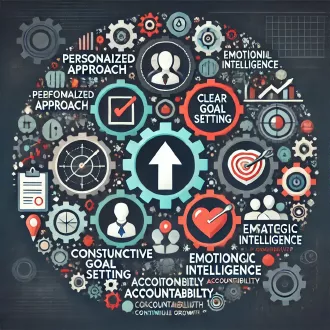Transcription Reaching an agreement with the customer
In the coaching process, the establishment of a coaching agreement, also known as a coaching contract, plays a crucial role in the transition from discussions and reflections to concrete action and goal achievement. It is the moment when conversations and reflections are translated into a clear and measurable action plan.
This engagement process should not be misconstrued as a legal formality; rather, it is a covenant that weaves collaboration and joint accountability between coach and coachee in the pursuit of tangible results.
Imagine that previous conversations with your coachee have revealed needs and goals. You have explored in depth their concerns, objectives and potential. But now, it's time to take those conversations to the next level and determine what the next steps will be. This is where the coaching agreement comes in. It is a document that puts in writing the mutual commitments and the steps to be taken to achieve those goals.
Some specific points this agreement may contain are:
- Mutual commitment. In the agreement, you will find the names of the coach and coachee, a simple but essential way to establish the identities and parties involved in this transformative collaboration. At this point, it's not just a casual conversation; it's a formal commitment to growth and development.
- Confidentiality agreement. It is essential to establish a confidentiality agreement to determine what information shared during coaching sessions is to be kept private and secure, what the boundaries of confidentiality are. This fosters an environment of trust and openness.
- The duration of the agreement. This is another critical component. It establishes how long the coaching process will last. It can vary depending on the objective and nature of the process. It can be weeks, months or even years. By specifying the duration, a time structure is established that will guide the path to the desired results.
- Defining objectives and goals. This is not only about time, but also about focus. In the agreement, you set specific goals that you aspire to achieve during the coaching process. These goals act as beacons that guide every session and every action. By clearly defining what you want to achieve, you set a clear course for success.
- Designing the coaching plan. The coach and coachee collaborate to design a customized coaching plan. This plan includes specific strategies, activities and approaches that will be used to address the objectives.
- Modality of the meetings. Modality is also critical. In an increasingly connected world, the options are diverse. You can opt for face-to-face meetings or virtual meetings through platforms such as Zoom, Skype or Google Meet. The choice of modality takes into account not only convenience, but also the effectiveness of communication and interaction.
- Identification of roles and responsibilities. The coaching agreement is not just a list of demands; it is also a platform for collaboration and co-creation. The coach and coachee not only establish what the coachee will do, but also how the coach can contribute. Determine what the coach will do and the coachee's expectations. It is about recognizing that both have an active role in the change process. This collaboration not only increases commitment, but also strengthens the partnership relationship in the pursuit of progress.
- Evaluation of progress. The agreement should include a method for evaluating progress throughout the coaching process. This may involve regularly reviewing objectives and adapting the coaching plan as needed.
- Flexibility and adaptability. But the coaching agreement is not static; it is a constantly evolving document. As the process progresses, updates and evaluations are made. What was accomplished? What was learned? How did you move toward your objectives? These reflections are essential to adjust and redesign the action plan as progress is made.
- Alignment of values and methodologies. The coach and coachee should discuss and align their values and methodological approaches. This ensures that both are on the same page and that the coaching process is conducted effectively and ethically.
This mutual commitment is sealed with signatures. It is not simply a formality, but a symbol of commitment and accountability. It is the formal starting point towards the desired transformation.
customer agreement




